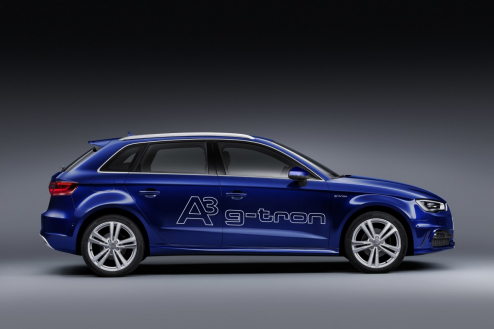Audi e-gas
By 2013, the Audi a-gas project will make the brand with the four rings the first automaker worldwide to have built a whole chain of sustainable energy sources.
The Audi e-gas facility in Werlte, northern Germany, which Audi is currently building in cooperation with its partner firm SolarFuel, will be the world’s first industrial-scale installation to generate synthetic natural gas from CO2 and renewable electricity.**
It runs on renewable electricity from sources such as wind and solar power or biomass. The facility, with its rated input of around 6,000 kW, will use primarily wind power when there is a temporary excess, thus helping to solve one of the core issues impacting the shift to alternative energy.
At the facility in Werlte, the first process step uses electrolysis to convert renewable electricity into hydrogen (Audi e-hydrogen), the fuel for future fuel-cell cars like the Audi Q5 HFC. Two high-pressure cylinders store the hydrogen in this technology prototype at a pressure of 700 bar; a polymer-electrolyte membrane fuel cell (PEM) with a power output of 98 kW supplies the energy for the electric drive. Together, the two electric motors deliver 90 kW and 420 Nm of torque.
However, as the necessary hydrogen supply infrastructure is not yet in place, Audi is addressing this problem through a further innovative process step. When the hydrogen is combined with CO2 in the methanization facility downstream of the electrolysis the result is synthetic, renewable natural gas – Audi e-gas.** This can then be fed directly into the natural gas network and stored there.
The CO2 comes from a biogas plant that is fed not with energy plants but with organic waste, thus avoiding the conflict with food production. The CO2 used is a waste product that would otherwise enter the atmosphere.**
The Audi e-gas facility bond the CO2 into the fuel, making Audi e-gas a climate-neutral fuel. When it is subsequently burned in the engine, the amount of CO2 released is exactly the same as the amount previously bonded into the fuel in the e-gas facility.**
Audi e-gas is an energy-rich fuel that is chemically identical to fossil methane, the primary constituent of natural gas, and is ideally suited to powering internal combustion engines. Starting in 2013, the facility in Werlte will produce a planned 1,000 tonnes of methane per year, thus binding 2,800 tonnes of CO2.** This renewably generated Audi e-gas is sufficient to run 1,500 Audi A3 Sportback TCNGs CO2-neutrally for 15,000 kilometers per year. In 2015, Audi intends to launch a second TCNG model based on the A4.**
In the medium term, the German energy economy could also benefit from the concept of the Audi e-gas project because it answers the question of how electricity produced in an environmentally friendly manner can be stored efficiently and independent of location. If there is plenty of wind blowing, excess electricity can be converted into Audi e-gas and stored in the public gas network – with its 217 terrawatt hours of capacity, it is by far the largest energy storage facility in Germany. The energy can then be fed as and when required from the gas network back into the electricity grid.
The potential of electricity/gas coupling to store wind or solar power in large quantities can provide powerful impetus to the renewable energy movement. The Audi e-gas project can easily be carried over to all countries with natural gas networks.
Audi’s involvement in initiatives addressing the production of clean electrical energy comes under the heading of Audi e-power. In April 2010, Audi joined the international consortium Desertec Industrie Initiative (Dii GmbH). Its long-term goal is to generate climate-friendly solar energy in the deserts of North Africa and the Middle East. Audi is the only automaker worldwide to be part of the consortium as an associated partner, with the brand’s initial involvement being in the establishment of the necessary framework conditions and the associated infrastructure.
The sun shines in the deserts of the Middle East and North Africa alone with 630,000 TWh of energy every year – which equates to 30 times the amount of electricity generated worldwide in 2010. In the sunniest regions of the earth, solar power stations on an area of 83,000 square kilometers – around the size of Austria – would theoretically be sufficient to satisfy all current global electricity needs.
The industrial initiative has set itself the target of, by 2050, meeting most of the power needs of North Africa and the Middle East, and a smaller proportion of European needs with electricity generated from solar and wind power. Audi sees enormous potential within the project for a sustainable energy supply.
The brand with the four rings wants to use some of the electricity from the Desertec project to produce and drive its e-tron vehicles. In parallel to this, excess solar electricity can, when necessary, be stored in the gas network. Another approach being pursued by Audi e-power is its involvement with a company that manufactures components for solar power stations – a technology that enables flexible electricity production.
**Figures depend on the tires/wheels used.
Status: 2013
